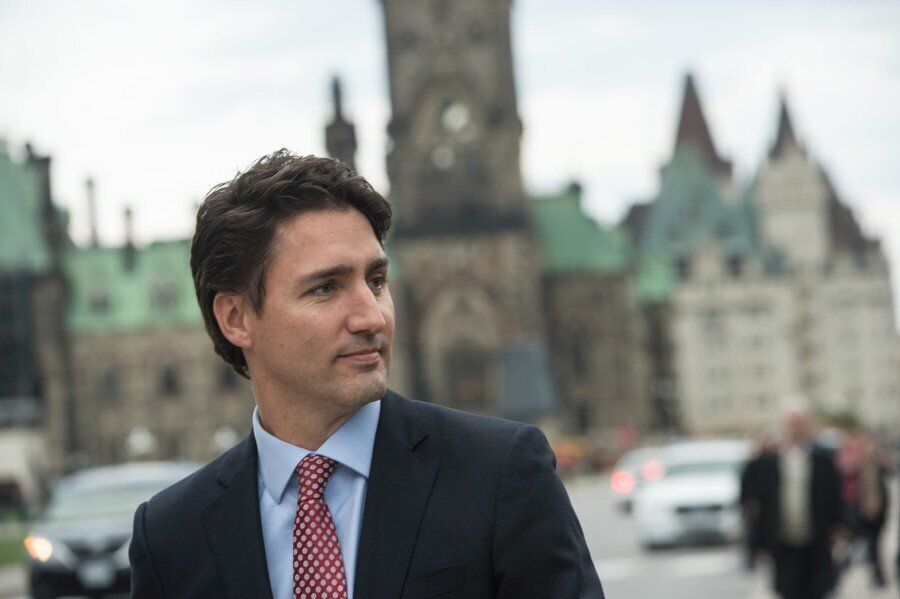
Monday’s historic Liberal victory may have surprised some Canadians, but it didn’t come as a shock to Justin Trudeau and his closest advisers. It was the culmination of a 2½-year strategy that they say was executed perfectly, a leader who rose to the occasion, and a bit of luck handed to them by the Conservative and NDP brain trusts.
It was also the vindication for Trudeau and those closest to him that positive politics could work, and negative personal attack ads were not necessary to reach 24 Sussex Drive.
Back in July, when the Liberals looked to be heading into the election in third place nationally, the president of the party’s ad firm, Bensimon Byrne, warned the Trudeau team that their planned messaging would fail and they needed to go negative.
"'Real Change' is not going to work,” Jack Bensimon told them. The previous month, Trudeau had already unveiled “Real Change” as his campaign slogan while announcing a 32-point plan to make government more open and transparent.
The NDP owns change, he said, and two brands can’t occupy the same position in people’s minds. Generations of Canadians had been conditioned to think that, no matter what policies the parties developed, the NDP would be seen as the agent of change and its leader, Thomas Mulcair, the least like Conservative Party Leader Stephen Harper.
“Instead of positioning ourselves as the best option, we need to become the least bad option,” Bensimon wrote to Trudeau’s closest advisers Gerald Butts and Katie Telford in an email shared with other staff. “Since that is the antithesis of why you and Justin got into politics, it would be entirely reasonable to reject this out of hand. But I believe my responsibility is to suggest a strategy that could work, even if you reject it.”
David Herle, a frequent CBC pundit who was involved with the Trudeau team’s ad strategy, agreed with the ad agency and argued strongly that the Liberals should run negative ads against Mulcair.

Butts and Telford disagreed. Liberal attack ads would backfire, they said. Canadians would see that strategy for what it was: putting partisan interests ahead of voters’ interests, Butts wrote in an email. It would also do nothing to counter the perception — implanted by millions of dollars of Conservative attack ads — that Trudeau wasn’t ready for the job.
First, they needed to get back in the game, and then, they thought, Trudeau would be able to rally people around him with a hopeful message that a better Canada was possible.
“We will win this on hope and hard work. Hard work by the campaign and ‘hope for a better Canada for you and your family’,” Butts wrote.
That was pretty much the same message Trudeau had been repeating ever since he’d launched his bid for the Liberal leadership on Oct. 2, 2012. He wanted to offer Canadians a leader they felt they could trust, he told the crowd assembled in Montreal, someone focused on their hopes and dreams, and someone who believed “better” was possible.
He stuck to that message for three years, and on Monday, it delivered the Liberal party a gain of 150 seats in one election, the party’s biggest victory ever, and its highest percentage of the vote since Jean Chrétien in 2000. Suddenly, a party that had been on its deathbed four years ago had roared back to relevance.
In the Beginning
The story of the Liberals’ campaign success begins long before the election was called, and before Trudeau won the leadership in April 2013. It can be traced back to a long weekend at the end of July 2012 in the picturesque Laurentian town of Mont-Tremblant, Que.
Trudeau had assembled his close friends, advisers, and family members, to discuss his very likely bid for the Liberal leadership and to map out a plan for victory. Among others, the group included:
• Sophie Grégoire-Trudeau, his wife
• Gerald Butts, his best friend from university and trusted adviser who had been Ontario premier Dalton McGuinty’s principal secretary. He left to run the World Wildlife Fund before scandal hit the Ontario Liberals.
• Katie Telford, Butts’ former Queen’s Park colleague and Stéphane Dion’s one-time deputy chief of staff. She would become the campaign’s co-chair.
• Tom Pitfield, a family friend who would serve as digital strategist.
• Pitfield’s wife Anna Gainey, now the Liberal party president.
• Former Mississauga MPs Navdeep Bains and Omar Alghabra, who were encouraging Trudeau to run and were both re-elected Monday.
Together they discussed the future of the party: Was it worth continuing as a separate party (yes); should it merge with the NDP (no, they were too different); how would they rebuild the Liberal Party (re-engage Canadians, make it competitive and build up its fundraising capacity); would they hold open nominations (they leaned towards yes, and Trudeau later became adamant); how many elections would they need to pull it off (one maybe, possibly two).
“When you took an initial seat scan, nobody had ever done this before,” Butts told The Huffington Post Canada in an interview this week. “The conventional wisdom was: you can’t go from 35 to a majority government in one election, so you should concentrate on making incremental progress rather than making a transformational jump.”
They thought it might be possible, he said, but a lot of work needed to be done first.
The party had 35 seats in the House of Commons then, one more than they had earned on election night in 2011 when the Grits sank to the lowest seat count in their history, and the party’s share of the popular vote fell below 19 per cent. Traditional Liberal supporters had deserted the fold. Elections Canada had de-registered several riding associations. The party’s fundraising was far from competitive with the Conservatives.
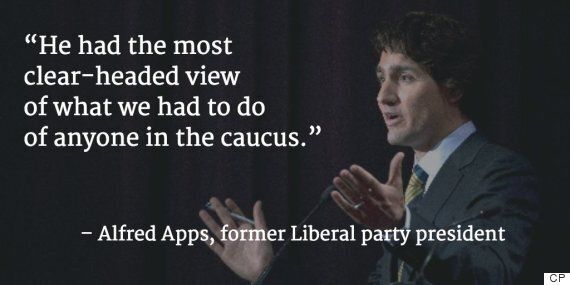
Those “dark days,” as then-party president Alfred Apps calls them, were the catalyst the party needed to modernize. He began urging Liberals to re-engage and reform their party, and Trudeau became deeply involved in the renewal process.
“He had the most clear-headed view of what we had to do of anyone in the caucus,” Apps said of his fall 2011 meeting with Liberal MPs.
Trudeau spoke in favour of a controversial idea at the party’s January 2012 convention to allow non-members to vote for the new Liberal leader. Some felt establishing a “supporter” class was risky and that it would alienate loyal volunteers. Instead, it added 300,000 new individuals to the Liberals’ database, helping identify potential supporters and future volunteers, and vastly expanding the Liberals’ donor base.
“It was a always a possibility [to win in one election] and, frankly, it was always the goal, but the risk of making it No. 1, or the foremost goal, can be really distracting,” Alghabra said. “The idea was to keep the eye on the ball… [and not] lose sight of the basics, because you are chasing certain polls or policies.”
A lot of the discussion in Mont-Tremblant focused on how the party could rebuild. “The idea was that if you focus on rebuilding the party and rebuilding the image of the party and the issues that the party stands for, political success will follow,” he said.
“It was a genuine call to action that inspired me and gave me hope, and I think it certainly paid off,” Alghabra added.
Two months later, Trudeau announced in his home riding of Papineau that he would run for the party’s leadership. Seven months after that, he won, by a landslide of nearly 80 per cent.
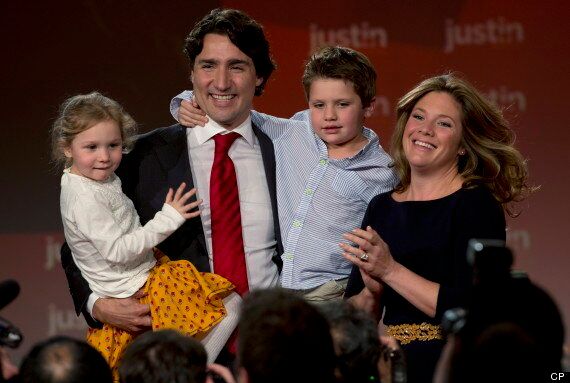
Justin Trudeau celebrates winning the Liberal party leadership in 2013 with his family on stage. (Photo: Canadian Press)
Planning for the election — the real race — had begun months earlier.
Trudeau’s advisers had already determined their pathway to success. “We said we needed to dominate in Atlantic Canada, do better in francophone Quebec, all but sweep Ontario, get a foothold in the urban West and win the Lower Mainland. That is exactly what we did,” Butts said.
The Liberal leader began touring extensively. He went to British Columbia and declared that the Liberal party would legalize marijuana. He went to Calgary and declared that the city, the province of Alberta and all of Western Canada had an important role to play in Canada’s shared future. He repeatedly returned, and even announced his climate change plan in Calgary. The Liberals had not won a seat in the city since 1968; on Monday, they won two in Calgary.
Trudeau also spent a lot of time in Quebec, in Montreal especially, but also Laval, the South Shore, Québec City, Gaspé, Saint-Tite, Mirabel, Saguenay, Gatineau. Many of those ridings were won by Grits as they picked up 40 seats in the province.
The Liberals also devoted resources — having finally learned from past experiences with leaders Dion and Michael Ignatieff —to counter the Conservative attack ads. The day after Trudeau was elected, the Tories released a set of ads suggesting he was “in over his head.”
The Liberals responded with an ad with Trudeau saying he would “work hard to earn your trust." A year later, they changed the messaging to say he was “getting ready to lead.”
The Tory attack ads, which featured Trudeau mock-stripping at a charity event and fairy dust over his head, didn’t stick. Unlike with the caricatures of Dion and Ignatieff, most Canadians knew a little bit about Trudeau and they were willing to give him the benefit of the doubt. (The ads in the spring of 2015 that suggested he just wasn’t ready were far more damaging).
The Liberals enjoyed a long honeymoon period. They led in public opinion polls and the party was identifying more Liberal supporters. Open nominations were bringing in more members and more volunteers. Candidates were already knocking on doors, making contacts and building up the Liberals’ future get-out-the-vote. Several star candidates were generating positive buzz. Fundraising was up. Way up.
Trudeau’s team also made significant changes to the way the party functioned.
In September, Butts brought in Christina Topp, who ran fundraising for him in his previous job at the World Wildlife Fund. She changed the way the party asked for money — mostly via email solicitations — by using data to determine the right way to connect with someone. The party also focused a lot of energy on engaging donors, thanking them and keeping them informed, she said, “because they are not only donors, they are supporters, ambassadors and voters.”
Cash started rolling in. Trudeau was especially successful at raising small amounts of money from large amounts of people. The year before he became leader, in 2012, the Liberals had raised $8,166,657. They raised $11,292,845 in 2013 — about $9.6 million after he became leader.
In 2014, they raised $15,063,142, a 31.6 per cent increase over the previous year. By the time the writs were issued on Aug. 2, the Liberals had raised about $8.6 million in the first six months of 2015.
“In short, every quarter from Q3 2013 to Q3 2015 has been a best ever quarter… with the exception of Q2 2014 which was essentially flat to Q2 2013, when he was elected leader,” Topp wrote in an email.
Trudeau’s team also established a new mobilization effort that included setting up regional hubs and hiring field workers. It also included a total revamp of the way the Liberal party was reaching out, engaging, and training its volunteers. Telford and Butts credit Hilary Leftick, the party’s director of volunteer mobilization, who had been running the music festival Pop Montréal, for the 80,000 volunteers the Liberals mobilized for this election. The impressive force made more than 11 million door knocks and phone calls with voters.
By the fall of 2014, the Liberals had built a program that would track in real time what was happening at the doors, what messages were working, what strategies were not — and allow them to change tactics. In Vancouver South, for example, the party discovered volunteers needed to focus the efforts on door-knocking when the weather was bad, otherwise most people were just not home.
They also devoted significant resources to a new digital strategy. Through Facebook and other social media platforms, the Grits canvassed for potential supporters. They reached out with targeted messages and worked to pull their vote out through YouTube and Facebook.
In August 2014, just before the party’s caucus and election readiness meetings in Edmonton, Butts and Telford looked at several of their own metrics as well as the other parties’ positioning, and realized a majority was possible – no sure thing, but in the realm of possibility. Trudeau was connecting well with Canadians and their organization had come together better and faster than they anticipated.
“That’s when we talked to caucus and said, ‘Up until now we have been thinking about it this way, but now we are starting to think it could be in reach, and these are the different paths we could be looking at,’” Telford said in an interview.
Trudeau, she said, was also confident.
Telford walked the caucus through the party’s plan — the ridings she would look at as well as the metrics that would guide where resources should be prioritized.
The change sentiment was “so strong and so widespread” that the Liberal advisers concluded that somebody other than Harper was going to win the election. But if that somebody was the NDP, the Liberal party would be dead, Butts believed.
“The conclusion we drew was that we were either going to win the election or the party was going to disappear,” he said.
Back then, it looked like the 2015 election was going to be a two-way fight between the Liberals and the Conservatives. Things soon began to change.
In October, Trudeau made a flippant comment on the use of CF-18s and the Liberals adopted a position opposed to the bombing mission against the Islamic State that proved unpopular with some supporters. Two terrorism incidents later that month — one in Saint-Jean-sur-Richelieu, where Warrant Officer Patrice Vincent died after being rammed by a car, and another in Ottawa, when a lone gunman shot Cpl. Nathan Cirillo at the cenotaph then charged into Parliament’s Centre Block — began to erode Liberal support.
Then in February, the Liberals announced that they would support the anti-terrorism Bill C-51. The party’s numbers continued to slide.
“C-51 definitely seemed to have an impact,” one Liberal said, speaking on condition of anonymity. Internally, Trudeau’s team disagrees about the damage the Liberals’ muted support for the anti-terrorism bill caused them. One person said focus groups found few people knew anything about the proposal, but others suggested the bill allowed the NDP to gain the mantle of change by painting Trudeau as siding with Harper.
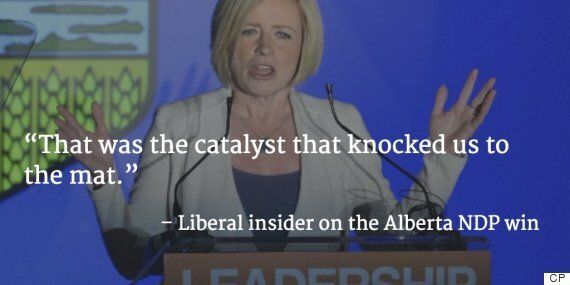
In May, the Liberals were dealt a bigger blow when the NDP in Alberta swept the province, giving federal New Democrats a huge boost.
“That was the catalyst that knocked us to the mat,” said another Liberal insider, who was not authorized to speak publicly. “All those voters who were probably with the Liberal party because they thought the Liberal party was the best way to get rid of Harper suddenly jumped to the NDP. We dropped six points within a week. It’s pretty unprecedented for that kind of fall outside of an election period,” he said, about the party’s internal polling numbers.
The Alberta election, coupled with the Tories’ spending $12 to $15 million (according to Liberal estimates) on attack ads suggesting Trudeau wasn’t ready to be prime minister, catapulted the NDP to first place in the polls. The NDP, rather than the Liberal party, was emerging as the option for change.
“That really made people refocus on making sure that Trudeau was embodying change,” the Liberal said. Trudeau’s team was going to have to work hard to earn those change voters, rather than having them vote for the Grits by default.
The Liberals responded by releasing concrete policy.
“That had been one of the criticisms early on, that we hadn't put our ideas, our platform out… People wanted to hear what were we about and what we wanted to do,” Gainey, the president of the party said. "We wanted to give people something to chew on."

(Photo: Canadian Press)
Trudeau’s first announcement in May at Gatineau, Que., was the Liberals’ response to the Tories’ income splitting plan and its well-liked Universal Child Care Benefit cheques. The Liberals promised more generous means-tested tax-free cheques, a middle-class income tax break, and a plan to tax the country’s top one per cent of income earners to help pay for it. They called it a “fairness” plan.
In June, Trudeau unveiled a 32-point plan to reform government to make it more open and transparent. He stood behind a lectern that featured his campaign slogan: Real Change.
"The transparency [announcement] was indicative of the kind of change Justin wanted to bring to Ottawa,” said Pitfield, Trudeau’s childhood friend and the Liberals’ director of digital strategy. “In some ways, it was our response to C-51 … that Canadians should not feel government was closed.
"It was an ambitious platform — covering everything from access to information reforms to reforming the electoral system — Pitfield noted. “[It was] probably more than we needed to put out. But the policy had been written, so why not put it out?”
“In retrospect, actually, having that near-death experience or the Alberta shock, was probably good,” another Liberal adviser told HuffPost. “It forced us to really refocus on earning those change voters and making sure that everything he did was to court people who wanted change, both from a stylistic perspective….
“That’s partly where the tone came from, moving away from Harper’s negativity and his style and pitching Justin as the anti-Harper, a guy who is going to be new and fresh … [and] the harder sell [of] pitching to people that he was actually going to bring change from a policy perspective, because the NDP, by virtue of never having been in power, they are change, right?
“There is nothing bigger than going with the NDP. So from there we really had to be focused on the policy planks and show change, whether that be taxing the wealthy, or the deficit infrastructure plan or transparency stuff to really court those change voters and bring them onside.”
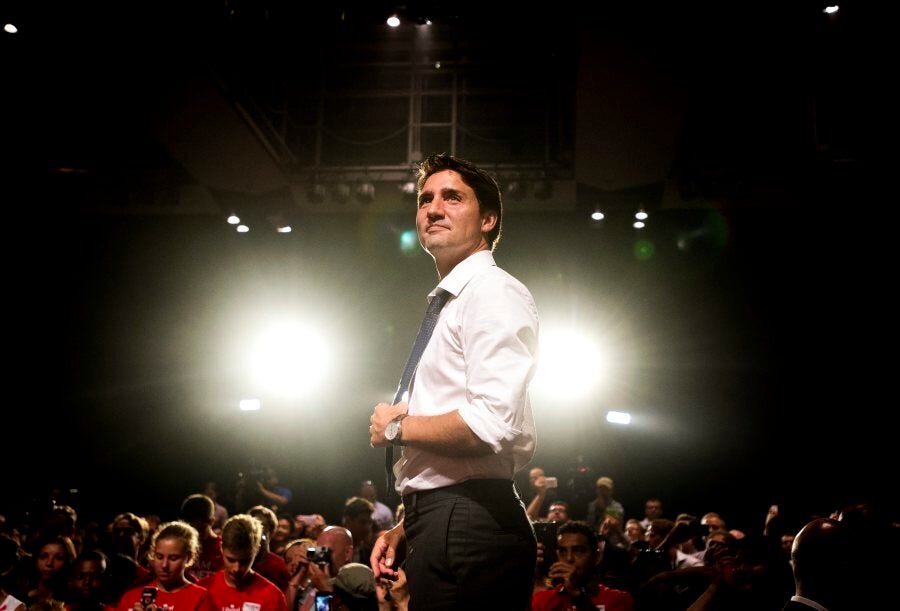
(Photo: Canadian Press)
The Election
When the writs were drawn up on Aug. 2 and the country headed towards the longest election in modern Canadian history, the Liberal party was third in the national polls. The public opinion aggregator, ThreeHundredEight.com, placed the NDP at 31 per cent, the Conservatives at 29 per cent and the Liberals at 26 per cent. The Liberals’ own polling suggested they were trailing in every age group, running a distant third with men, losing their edge with women voters, and, aside from Atlantic Canada, trailing in every region of the country.
This wasn’t the scenario Trudeau’s team hoped for when they had mapped out their strategy. They wanted to be ahead of the NDP going into the election so they could be seen as the best agent for change.
Their first task was to fight their way back into the race. Trudeau needed to come out strongly in the Maclean’s debate, the first of five leaders’ debates, held on Aug. 6.
He did.
In his closing remarks, which were mocked by some and loved by others, Trudeau asked Canadians to believe that a better country was possible.
“In order to know if someone is ready for this job, ask them what they want to do with this job, and why they want it in the first place,” Trudeau said, looking straight into the camera. The Liberal leader would spend the rest of the campaign telling Canadians just want he wanted to do.
Sometimes he would be mocked for it — commentators in Quebec noted that he sounded like a “tape recorder” during the Radio-Canada leaders’ debate — but in the end, Canadians would know that Trudeau planned to cut taxes for the middle class, raise them on the top one per cent of income earners, run deficits for three years to fund infrastructure spending, and lift 315,000 children out of poverty.
If Trudeau had flopped during the Maclean’s debate, as his opponents seemed to expect, the story of the 42nd election campaign would have been very different. But Butts, Telford and company were confident their leader would perform well. That evening, the party kicked off a major national television ad buy that showcased Trudeau walking towards the camera, telling Canadians that he was “ready” to lead. The ads were written by Butts and Bensimon Byrne’s creative director, David Rosenberg, whom Butts credits for much of their success.
The spots were a direct salvo to the Conservative attack ads, in particular the one that suggested Trudeau was “just not ready,” which left a big impact. People in focus groups were parroting lines that Trudeau didn't have the necessary experience and that he had once said “budgets balance themselves,” according to a Liberal who attended the meetings. The party’s own data suggested a third of Liberal voters thought Trudeau wasn’t ready to be prime minister.
“Ready” had become the ballot question, the Liberal said. “Is he ready or not? It was kind of impossible to ignore.”
Then in two weeks, with a $4-million ad buy, the Liberals believed they had countered the Tories’ attack.
In July, focus-group testing of the “Ready” ad, which ran in French and in English, suggested this was the best advertisement the Liberals had so far designed. Men who had written Trudeau off suddenly thought he was “prime ministerial,” “confident,” and “optimistic.”
But it wasn’t all positive; people criticized the fact that Trudeau was repeating the Conservative charge against him. But, as Trudeau’s advertising director Suzanne Cowan summed up: “By the end of the campaign, we owned ‘ready.’"
“That ad saved our campaign. Well, that, and the Maclean’s debate put us back in it,” another Liberal adviser said. “And the Tories, because they hate him so much, underestimated his ability to deliver that performance. When if you really pay attention to the guy’s career, every time it is all on the line, he delivers.”
Pitfield agreed. “‘Real Change’ and ‘Ready’, got us back in the game.”
The Liberals’ second task was to best the NDP on representing change.
They wanted to beat Mulcair on leadership (“do I like the guy?”) and on policy attributes (“what does he want to do?”). The Liberals went about this in several ways.
First, they tried to portray Mulcair as a man who would say and do whatever it took to get elected. The Liberals suggested Mulcair said different things in English and in French on core issues, such as the separation of Quebec, the Energy East pipeline, and oilsands development.
They were aided in their campaign by several media stories that dug into Mulcair’s own record at the Quebec National Assembly, where he promoted bulk water exports and praised former British prime minister and right-wing icon Margaret Thatcher. The incidents that not only made him seem Harper-esque and right-wing, but also untrustworthy.
Early on in the campaign, Mulcair also gave the Liberals opportunities to draw parallels between his and Harper’s way of doing things, such as when the NDP leader decided not to take reporters’ questions the day the election was called, or not to participate in the English television consortium debate or pulling out of the women’s debate despite Mulcair’s having agreed to it one year earlier.
Second, through their communications and ad strategy, Trudeau and the Liberals tried to show that Mulcair’s plan was full of holes, and that, in the words of one adviser, he had released a cynical platform with empty promises to make Canadians believe he cared.
“The NDP’s program is a mirage,” Trudeau declared in French when he launched his campaign in Quebec in early August. “The NDP’s big promise of a $15 an hour minimum wage will only apply to less than one per cent of workers who make minimum wage,” he said. “The NDP’s other big promise of a $15 a day child-care plan won’t kick in for eight years, [and] won’t change anything in Quebec. Quebecers already have better.”
In September, the party began targeting voters in ridings where the Liberals were neck-and-neck with the NDP, with a fact-check of the NDP’s promises. It showed most people were not going to benefit immediately, or at all, from Mulcair’s promises.
In Quebec, the Liberals ran radio and television ads noting that Mulcair’s daycare plan would offer them nothing new, while Trudeau would provide more generous children’s benefits.
Third, the Liberals stressed that Mulcair agreed with Harper and opposed many progressive elements of the Liberal platform. The party’s focus groups had found that people thought the Liberals’ platform, which tilted left, actually belonged to the NDP.
“Mr. Harper wants to give money to those who need it less, and Mr. Mulcair agrees with him,” Trudeau often repeated on the campaign trail, trying to tie both men together.
On Aug. 25, Mulcair announced that an NDP government would run balanced budgets. Two days later, Trudeau announced a three-year plan of what he deemed to be modest deficits of up to $10 billion to spend on mostly infrastructure projects. Trudeau had toyed with the idea for well over a year but had made his mind up only in July.
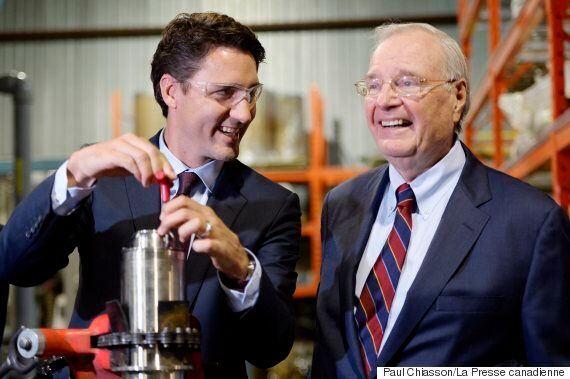
Justin Trudeau, left, and former Liberal prime minister Paul Martin on the campaign trail. (Photo: Paul Chiasson/Canadian Press)
In the days that followed, Trudeau would call on former prime ministers Paul Martin and Jean Chrétien to help sell the idea of deficits with blue Liberals or red Tories, while highlighting the party’s credentials as deficit slayers.
Trudeau’s decision to run deficits would prove to be the single biggest demarcation point between the Liberals and the NDP.
“My biggest concern in the summer time was that they were going to do that before we did,” Butts told HuffPost.
Not only would deficits allow the Liberals to spend more than the NDP and invest in an economy that the Bank of Canada confirmed several days later was in a recession, Liberals hoped Trudeau’s promise would make him appear like a leader who was authentic and honest.
“Deficit was the proof point that you were willing to take a risk for the courage of your conviction. We weren’t going to tell people that you could have your cake and eat it too. We were being honest,” Butts said.
In early September, the Liberals launched a new ad — the escalator ad — with Trudeau walking up steps that kept going down, and suggesting that under Harper it was harder to get ahead. Mulcair meanwhile was promising “more cuts” and now, wasn’t the time for that, the Liberal leader said. His plan: kick start the economy with new investments.
"That’s real change."
Later in September, when the NDP released its fiscal costing, the Liberals would point out that many of the NDP’s spending commitments would be funded only later in its mandate. Mulcair’s opposition to Trudeau’s pledge to scrap the F-35 purchase created further space between the parties.
The Liberals were making a big play for “real change.” Come October, the tour banners suddenly started saying: “Real Change Now.”
In mid-September, public opinion polling suggests the Liberals surpassed the NDP nationally. In the aftermath of the election, Karl Bélanger, one of Mulcair’s strategists, blamed the Tories for “blow[ing] up” the NDP’s campaign over the niqab. The issue came to the foreground on Sept. 15, when the Federal Court of Appeal dismissed an application by the government seeking to uphold the ban on wearing a facial covering during citizenship ceremonies. The Tories and the Bloc Québécois used the niqab as a wedge issue to dig at NDP support.
Speaking at an Ottawa luncheon on Wednesday, NDP’s national campaign director Anne McGrath said she thought the niqab issue led a lot of Quebecers to take a second look at the NDP and other parties and “shook them loose from where they had been.” Where they had been was about 47 per cent of popular support in the province; they dropped 17 points, according to one survey, in the 1½ weeks after the decision.
The NDP won 16 seats in Quebec on election night, down from 59 in 2011, while the Liberals — who held the same position, if not an even stronger one, on the niqab as the NDP — won 40 seats, up from seven in 2011.
"I think what the niqab debate also did was put a cherry on the top [of the argument] that Mulcair was two-faced. Because he refused to answer that question for so long, and then when it became clear that it painted him in a corner, that is when Quebecers started to realize that same narrative. He was struggling to take a side,” Pitfield told HuffPost.
Liberal candidates, like the NDP’s, were also freaking out. But they were told not to bring it up with Trudeau.

Justin Trudeau's team believes the NDP took Quebec seats for granted. (Photo: Canadian Press)
The Grits suggest the NDP took their voters for granted. “They had no plan. Daycare program we already have. Constitutional wranglings over the Senate,” Trudeau’s Quebec adviser Robert Asselin said. “I think people said: the orange wave is a great but what are they offering? And it should also be said, Mulcair didn’t have the charisma that [Jack] Layton did.
“The biggest error was taking for granted that those 57 seats in Quebec were theirs and they could win them easily and that Trudeau wasn’t an important adversary in Quebec.”
Most Quebecers have no political affiliation, Liberal pollster and Quebec strategist Sylvie Paradis told HuffPost. What you need to do is identify the issues that matter to them.
Paradis, who has been working with the Trudeau team for three years, said the Grits discovered through focus groups that Quebecers had an appetite for a leader with a vision. They disliked Harper, and they wanted change that represented their values. Mostly, they were concerned about making ends meet. Quebecers recognized the niqab as “a side show,” Paradis added, and were more receptive to the Liberals’ message that the party would improve their quality of life.
The Liberals believed their only path to government rested with increased support in Quebec. They not only reached out to Quebecers on issues that mattered to them — such as Trudeau’s opposition to the bombing mission against the Islamic State last year — but they also designed a specific ad campaign for the province.
They ran spots that introduced their team of candidates. Ads suggested Mulcair’s $15-a-day daycare plan would offer Quebecers — who already have a $7-a-day plan — nothing new, while the Liberals would give them bigger child benefits. And ads in the final two weeks of October featured people going to the polling station and hearing from Trudeau on the ballot question that mattered to them. That campaign, Paradis said, was designed with the knowledge that about 20 per cent of Quebecers make their decision in the voting booth. The Liberals’ internal numbers steadily rose.
The Liberals’ polling suggested Quebecers, more than anybody else in the country, wanted to get rid of Harper and were also open to changing their minds more than anywhere else in the country. But it wasn’t until the final few days of the campaign that Quebecers moved in droves to Trudeau. “That’s what pushed us from a strong minority to a majority,” one insider said. Going into the weekend, the Liberals thought they would win 155 seats. Late Sunday night, their internal numbers suggested 177 seats.
The next phase of the campaign started earlier than planned because the NDP was weaker than Trudeau’s team expected.
“I don’t know if the NDP is spinning the niqab [as the reason for their downfall] or if they are saying that because they don’t understand,” one Liberal said.
“We didn’t know that they were going to run on a 'bullshit' $15-an-hour promise,” he added. “We needed to show that they were phonies and that we were real. And they walked right into it. I’m not even sure they know what happened to them.”
The third part of the Liberal campaign was aimed at consolidating the anti-Harper sentiment, courting red Tories and mobilizing voters.
In mid-September, the party booked a large arena in Brampton, Ont. for what they hoped would be a huge rally that would create, and generate, a visible sense of momentum. The Liberals were telling Canadians that if they wanted change, their party was the best bet. The event, held on Oct. 4, attracted 7,000 people. Organizers and candidates had worked hard to pack the hall. Trudeau delivered a rousing speech.
To the largely South Asian crowd, Trudeau delivered a message of inclusiveness. “Stephen Harper has nothing to offer but fear itself. Fear of terrorism. Fear of the world beyond our borders. Fear of each other,” Trudeau said. “The prime minister’s job is to bring Canadians together, not to tear us apart.”
The Conservatives had spent the past three weeks campaigning on niqabs, promising to establish a barbaric practices tip line, and promoting Bill C-24, a law that strips dual citizens of their Canadian citizenship if they are convicted of espionage or terrorist offences. The Tories were hoping that publicizing Trudeau’s opposition to the bill would expose him as being weak and naive on the security front. Instead, it backfired among the very ethnic communities the Tories had courted for so long.
The Liberals used it as a wedge issue. They tapped into a fear shared by many immigrants that the new law lessened their citizenship compared to those born in Canada, or could be used to discriminate against their children.
Trudeau also used the Brampton rally to extend an open hand to Conservatives —red Tories — who had enough of Harper. “Conservatives are not our enemies, they're our neighbours,” Trudeau said. He would repeat this line on the road non-stop for the next two weeks.
“We have the chance to beat fear with hope,” Trudeau said. “This is Canada, and in Canada better is always possible.” The crowd cheered. The ad agency captured it all. This 60-second spot — which aired during the last weeks of the campaign — was designed to make people feel like they were part of a movement.
The following week, without much effort from organizers, thousands of people would show up for a glimpse of Trudeau at events across the country.
“I knew this was over when we showed up in Napanee [in Ontario], to pour coffee at a Tim Hortons and there were 400 people in a parking lot,” one adviser travelling with Trudeau said.
Telford had seen support rise in seats that were essentially third-tier ridings. These were ridings the Liberals had listed as low-priority but where they could easily move national resources, volunteers and radio ads to help their candidates ride a wave. She suggested that Trudeau’s tour drive from Ottawa to Toronto to make whistle stops in what were traditionally Conservative constituencies.
In Port Hope, Ont. (population 16,000), which had been Tory since 2006, Liberal organizers said 1,200 showed up to a campaign stop. In Winnipeg, people lined up block after block after block. In Alberta, on the last day of the tour, Trudeau spoke to more than 4,000 people in Edmonton and Calgary.
His campaign culminated in North Vancouver, a riding that had been represented by Trudeau’s grandfather, Jimmy Sinclair. Trudeau had flown several times to B.C. during the campaign. The party had invested significant resources, and ran an ad campaign stressing Trudeau’s roots in the province. His team believed B.C. would be key to his victory. And it was.
Throughout that week, newspaper front pages told the story of momentum that was building, but the Liberals still had one big problem. The Conservatives were running ads on TV suggesting that Trudeau would get rid of income splitting for seniors. Despite mentioning repeatedly that a Liberal government wouldn’t touch the program, candidates were getting hammered at the door.
“I got a lot of phone calls from the campaigns saying ‘Please help us with the seniors.’ Because the seniors vote,” Gainey said.
The Liberals called in Hazel McCallion, the legendary former mayor of Mississauga, Ont., for some help. The 94-year-old’s video on Facebook, which featured her saying, “Stephen, do I look scared to you?”, reached more than 3.4 million views. It was so popular they aired it on TV. It is credited for reversing the Liberals’ slide among voters 65 years and older.
The Liberals’ first real hiccup happened in the last week of the campaign, when news leaked that a senior member of Trudeau’s team had written an email to a few individuals at Transcanada Corp. with advice on how to lobby a new government. Campaign co-chair Dan Gagnier wasn’t a registered lobbyist and technically had broken no rules, but the email left the impression that the Liberal party was back to its old ways.
The Liberals initially defended Gagnier but hours later announced he had resigned. The leader’s tour continued. The NDP tried to capitalize on the incident, comparing it to the sponsorship scandal, but by then it appeared the Trudeau wave could not be stopped.
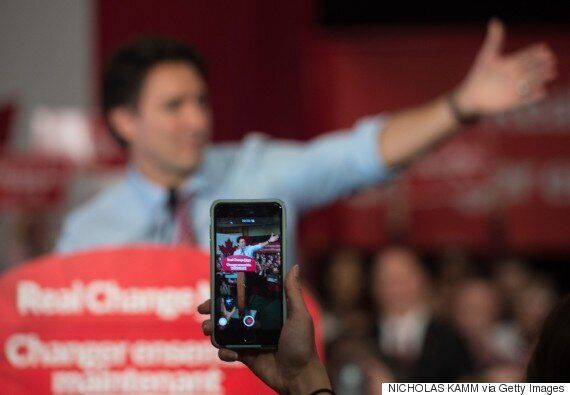
A supporter films Justin Trudeau as he speaks at a victory rally in Ottawa on Oct. 20, 2015. (Photo: Nicholas Kamm/AFP/Getty Images)
One of the main reasons the Liberals won on Monday was they brought new voters to the polls. Elections Canada’s unofficial numbers suggest the Grits received 4,147,060 more votes this year than in 2011, yet the NDP’s support dropped by only 1,051,149 votes, and the Conservatives lost 234,774 votes.
Voter turnout rose from 61.1 per cent in 2011 to 68.5 per cent — the highest since 1993. Official numbers are not yet available but young people may have participated in higher numbers. Elections Canada organized polling stations on some university campuses and community centres as a pilot project, and said about 70,000 people cast a ballot during advance polls.
The Liberals aimed much effort at getting young people out. They designed a campaign titled #matters that was focused on issues such as tuition, jobs, and pot. They reached out on Facebook and through direct voter contact, email, and compelling digital videos.
In ridings such as Ottawa Centre, where Liberal candidate Catherine McKenna beat high-profile NDP incumbent Paul Dewar, 10,000 more people voted this year than in 2011. In the Ontario constituency of Orleans, more than 13,000 new voters cast a ballot.
Party insiders consider their digital and voter contact strategy as key to their success. For more than two years, the party worked to tailor messages to certain types of voters, figuring out what would work to persuade some to vote Liberal while motivating others to believe their vote mattered. When the election was called, the Liberals had a wealth of information about potential voters and knew what message would work to reach specific voter groups in key ridings.
The Liberals’ internal numbers suggest they won every age group and every region of the country except Alberta and Saskatchewan.

Trudeau gestures to supporters on election night in Montreal. (Photo: Kevin Van Paassen/Bloomerg)
The Liberals believe their luckiest break — and the Tories’ biggest mistake — was calling a 78-day campaign. The Grits needed a lot of time to execute their strategy.
”The Tories did us a huge favour with a long writ, in that regard. A huge favour. It was so colossally stupid. What they thought they were going to do was basically drain us of money, that we were going to screw up the beginning of the campaign and that we would be out of it by Labour Day. And we knew we needed that time to motivate our voters.”
In the end, the Liberals estimate they spent slightly more than $40 million on the election campaign.
“It was a plan that was put in place by Gerald, and Katie, and Jeremy [Broadhurst, the party’s national director], and we all worked towards implementing that. The plan didn’t change, it just rolled out better than we could have expected,” Cowan said.
Telford concurs. “We weren't continuously reacting and responding to incidents over the course of the campaign. We had a plan and we stuck to it."
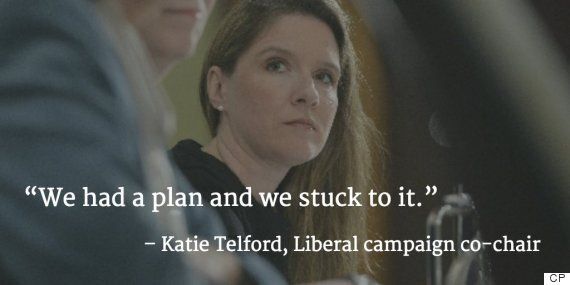
Butts stresses the campaign was a “great team effort” but Trudeau’s advisers all note none of it would have mattered without Trudeau.
“We were up against the ropes,” Pitfield said of that first leaders’ debate in August. “This [victory] is all him. All this helped. But it's all him."
The Liberal leader's ability to connect with voters, his performance in the leaders’ debates, his positive and uplifting tone, and sheer stamina brought them to where they are.
"Justin was the determining element. He carried the campaign on his shoulders,” said Quebec organizer and re-elected MP Pablo Rodriguez. “He showed courage, perseverance and was disciplined unlike the other candidates… And I think people started to attach themselves onto him and see themselves in him."
During his first press conference as prime minister-designate this week, Trudeau suggested the Liberals had been catapulted from third to first place because of an “extraordinary desire for change.”
“I have always felt optimistic about our chances if we offered the right kind of concrete but ambitious vision of this country that reflects what Canadians need and want,” Trudeau said. “That’s what we put forward and that’s what Canadians responded to.”
Those around him also felt optimistic.
Telford had bet the Grits would win 182 seats.
Butts had bet 183.
The Liberals won 184.
ALTHIA RAJ is the Ottawa bureau chief for HuffPost Canada.
